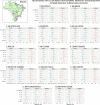Effects of Drought on Mortality in Macro Urban Areas of Brazil Between 2000 and 2019
- PMID: 35280229
- PMCID: PMC8902811
- DOI: 10.1029/2021GH000534
Effects of Drought on Mortality in Macro Urban Areas of Brazil Between 2000 and 2019
Abstract
A significant fraction of Brazil's population has been exposed to drought in recent years, a situation that is expected to worsen in frequency and intensity due to climate change. This constitutes a current key environmental health concern, especially in densely urban areas such as several big cities and suburbs. For the first time, a comprehensive assessment of the short-term drought effects on weekly non-external, circulatory, and respiratory mortality was conducted in 13 major Brazilian macro-urban areas across 2000-2019. We applied quasi-Poisson regression models adjusted by temperature to explore the association between drought (defined by the Standardized Precipitation-Evapotranspiration Index) and the different mortality causes by location, sex, and age groups. We next conducted multivariate meta-analytical models separated by cause and population groups to pool individual estimates. Impact measures were expressed as the attributable fractions among the exposed population, from the relative risks (RRs). Overall, a positive association between drought exposure and mortality was evidenced in the total population, with RRs varying from 1.003 [95% CI: 0.999-1.007] to 1.010 [0.996-1.025] for non-external mortality related to moderate and extreme drought conditions, from 1.002 [0.997-1.007] to 1.008 [0.991-1.026] for circulatory mortality, and from 1.004 [0.995-1.013] to 1.013 [0.983-1.044] for respiratory mortality. Females, children, and the elderly population were the most affected groups, for whom a robust positive association was found. The study also revealed high heterogeneity between locations. We suggest that policies and action plans should pay special attention to vulnerable populations to promote efficient measures to reduce vulnerability and risks associated with droughts.
Keywords: Brazil; age ranges; drought; gender assessment; mortality; vulnerability.
© 2022 The Authors. GeoHealth published by Wiley Periodicals LLC on behalf of American Geophysical Union.
Conflict of interest statement
The authors declare no conflicts of interest relevant to this study.
Figures



Similar articles
-
Multicity study of air pollution and mortality in Latin America (the ESCALA study).Res Rep Health Eff Inst. 2012 Oct;(171):5-86. Res Rep Health Eff Inst. 2012. PMID: 23311234
-
Analyzing the effects of drought at different time scales on cause-specific mortality in South Africa.Environ Res Lett. 2024 Apr 18;19(5):054022. doi: 10.1088/1748-9326/ad3bd2. Environ Res Lett. 2024. PMID: 38855580 Free PMC article.
-
Short-term effects of drought on daily mortality in Spain from 2000 to 2009.Environ Res. 2020 Apr;183:109200. doi: 10.1016/j.envres.2020.109200. Epub 2020 Jan 30. Environ Res. 2020. PMID: 32036270
-
Public Health Implications of Drought in a Climate Change Context: A Critical Review.Annu Rev Public Health. 2023 Apr 3;44:213-232. doi: 10.1146/annurev-publhealth-071421-051636. Epub 2023 Jan 9. Annu Rev Public Health. 2023. PMID: 36623928 Review.
-
[SENTIERI - Epidemiological Study of Residents in National Priority Contaminated Sites. Sixth Report].Epidemiol Prev. 2023 Jan-Apr;47(1-2 Suppl 1):1-286. doi: 10.19191/EP23.1-2-S1.003. Epidemiol Prev. 2023. PMID: 36825373 Italian.
Cited by
-
Mental Health and Community Resilience among Vulnerable Populations Affected by Natural Hazards: Protocol for Scoping Reviews.Methods Protoc. 2022 Oct 28;5(6):88. doi: 10.3390/mps5060088. Methods Protoc. 2022. PMID: 36412810 Free PMC article.
-
Mental health of vulnerable groups experiencing a drought or bushfire: A systematic review.Glob Ment Health (Camb). 2023 Apr 13;10:e24. doi: 10.1017/gmh.2023.13. eCollection 2023. Glob Ment Health (Camb). 2023. PMID: 37860103 Free PMC article. Review.
-
The Interactive Effects between Drought and Air Pollutants on Children's Upper Respiratory Tract Infection: A Time-Series Analysis in Gansu, China.Int J Environ Res Public Health. 2023 Jan 20;20(3):1959. doi: 10.3390/ijerph20031959. Int J Environ Res Public Health. 2023. PMID: 36767324 Free PMC article.
-
Risk and attributable fraction estimation for the impact of exposure to compound drought and hot events on daily stroke admissions.Environ Health Prev Med. 2024;29:56. doi: 10.1265/ehpm.24-00168. Environ Health Prev Med. 2024. PMID: 39428540 Free PMC article.
-
Long-term drought and risk of infant mortality in Africa: A cross-sectional study.PLoS Med. 2025 Jan 31;22(1):e1004516. doi: 10.1371/journal.pmed.1004516. eCollection 2025 Jan. PLoS Med. 2025. PMID: 39888958 Free PMC article.
References
-
- Agnew, C. T. (2000). Using the SPI to identify drought. Drought Network News (1994–2001). Retrieved from https://digitalcommons.unl.edu/droughtnetnews/1
-
- Algur, K. D. , Patel, S. K. , & Chauhan, S. (2021). The impact of drought on the health and livelihoods of women and children in India: A systematic review. Children and Youth Services Review, 122, 105909. 10.1016/j.childyouth.2020.105909 - DOI
LinkOut - more resources
Full Text Sources
